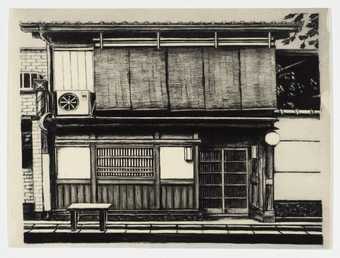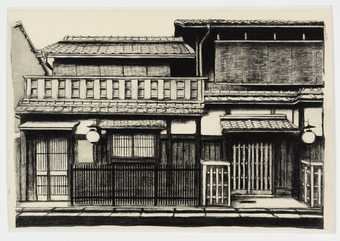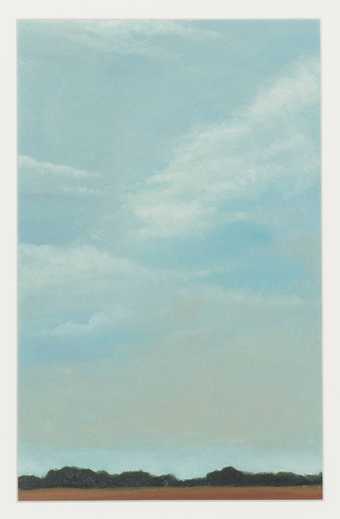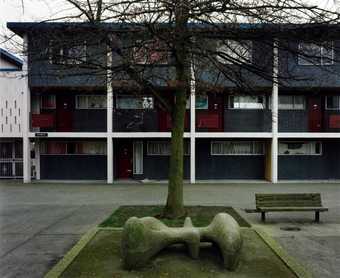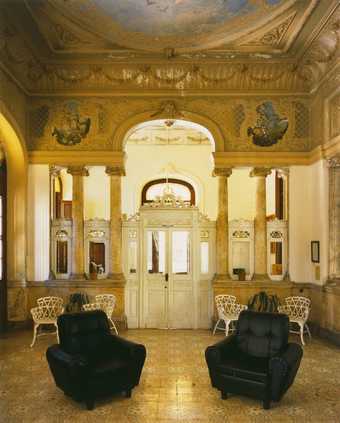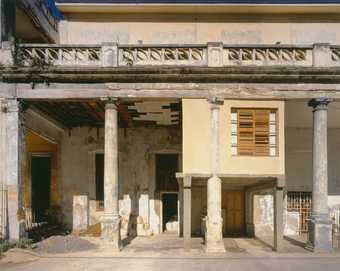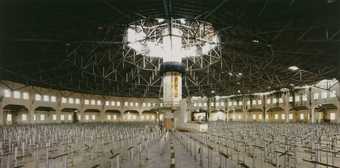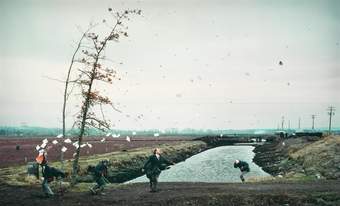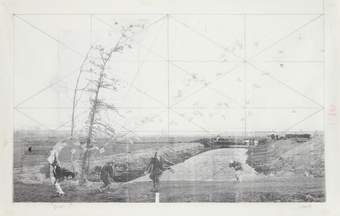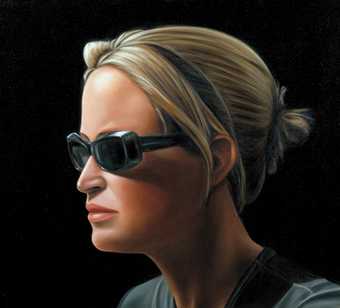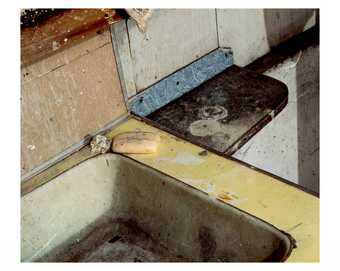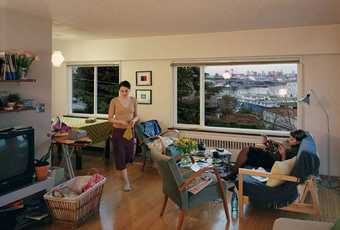Sorry, no image available
Not on display
- Artist
- Jeff Wall born 1946
- Medium
- Transparency on lightbox
- Dimensions
- Support: 1870 × 3510 × 260 mm
- Collection
- Tate
- Acquisition
- Purchased with funds provided by the Mary Joy Thomson Bequest 2006
- Reference
- T12294
Summary
Morning Cleaning, Mies van der Rohe Foundation, Barcelona is a colour photograph displayed as a transparency in a lightbox that measures over three and a half metres in length and almost two metres is height. It shows the interior of the German Pavilion in Barcelona, an iconic glass-walled building designed by the German architect Ludwig Mies van der Rohe (1886–1969). The minimally-furnished space is seen in the bright light of early morning. In the foreground, a gleaming steel pillar divides the composition vertically almost in half. Beyond the pillar, across an expanse of dark carpet, an attendant is in the process of cleaning a glass-panelled wall. The morning sun illuminates the clear and crisp lines of the building’s architecture, while producing pronounced shadows on a deeply veined onyx wall to the left. On the panels the custodian has prepared for cleaning, streaming water adds a random design onto the surface of the symmetrically-patterned glass, which partially obscures a courtyard where a sculpture of a female nude by Georg Kolbe (1877–1947) stands by a pond.
Mies’s pavilion was first constructed in 1928–9 for the 1929 International Exposition held in Barcelona. An important example of high modernist architecture, it was disassembled in 1930 at the conclusion of the exhibition, but reconstructed by Barcelona City Council in the 1980s because of its cultural significance. The Pavilion is now open to the public. Mies designed every detail of the Pavilion and its interior, including the steel Barcelona chairs and stools upholstered in white leather that are visible in Wall’s image. Whilst the building’s formal rigour and its opulent materials convey a sense of luxury, the appearance of a cleaner calls attention to the support systems necessary to maintain Mies’s artistic vision, which he characterised with the famous principle ‘less is more’. Wall has said: ‘[These] buildings require an especially scrupulous level of maintenance. In more traditional spaces a little dirt and grime is not such a shocking contrast to the whole concept. It can even become patina, but these Miesian buildings resist patina as much as they can.’ (Quoted in Burnett, pp.90–1.)
Wall has pictured cleaners in other works that, as this one, make visible activities which are normally unseen or overlooked. In Volunteer and Housekeeping, both 1996, a man mops the floor of a shabby drop-in centre kitchen and a chambermaid exits a pristine but nondescript hotel room (reproduced in Jeff Wall: The Complete Edition, London 2009, pp.102–3 and p.215, respectively). ‘Cleaning is mysterious,’ the artist has commented, ‘since it is the labour that erases itself if it is successful.’ According to Wall, the idea of maintenance is ‘to do with virtue. It’s about what we have to do to be virtuous.’ (Quoted in Burnett, p.90.) His concept for Morning Cleaning, Mies van der Rohe Foundation, Barcelona has its origins in an idea to depict a cleaner working in a private house and developed into this image after he staged an exhibition, entitled Odradek, at the Pavilion in 1999.
The artist has explained of this work:
The man in the picture is the real cleaner. The picture is documentary in the sense that that’s exactly what he would be doing at that moment of the day. It’s what I call ‘near documentary’. Although I arranged the picture and worked in collaboration with the cleaner, the picture resembles very closely what a snapshot made at that moment would show.
(Quoted in Burnett, p.90.)
Wall is based in Vancouver, Canada. Morning Cleaning, Mies van der Rohe Foundation, Barcelona was originally made in an edition of two (in the Kunstsammlung Nordrhein-Westfalen, Düsseldorf, and the Walker Art Center, Minneapolis). Tate T12294 is an artist’s proof.
Further reading:
Craig Burnett, Jeff Wall, London 2005, reproduced pp.112–3.
Vincent Honoré and Kate Paul, Jeff Wall: Photographs 1978–2004, exhibition guide, Tate Modern, London 2005.
Peter Galassi, Jeff Wall, exhibition catalogue, Museum of Modern Art, New York 2007, reproduced pp.130–1.
Alice Sanger
December 2010
Does this text contain inaccurate information or language that you feel we should improve or change? We would like to hear from you.
You might like
-
Lisa Milroy Kyoto House
1996 -
Lisa Milroy Kyoto House
1996 -
Lisa Milroy Sky
1997 -
Lisa Milroy Sky
1997 -
Stan Douglas McLean Park and False Creek
1998 -
Stan Douglas Biomorphic Sculpture at McLean Park
1998 -
Stan Douglas “La Inalámbrica” Building / Metropolitan Building, Habana Vieja
2004 -
Stan Douglas Quinta Rosario / “Fructuoso Rodríguez” Secondary School, Vedado
2004 -
Stan Douglas Barbacoa, Vedado
2004 -
Stan Douglas Mess Hall, Isla de Pinos / Isla de la Juventud
2005 -
Jeff Wall A Sudden Gust of Wind (after Hokusai)
1993 -
Jeff Wall Study for ‘A Sudden Gust of Wind (After Hokusai)’
1993 -
Lisa Milroy Girl
1998 -
Jeff Wall Diagonal Composition
1993 -
Jeff Wall A View from an Apartment
2004–5

